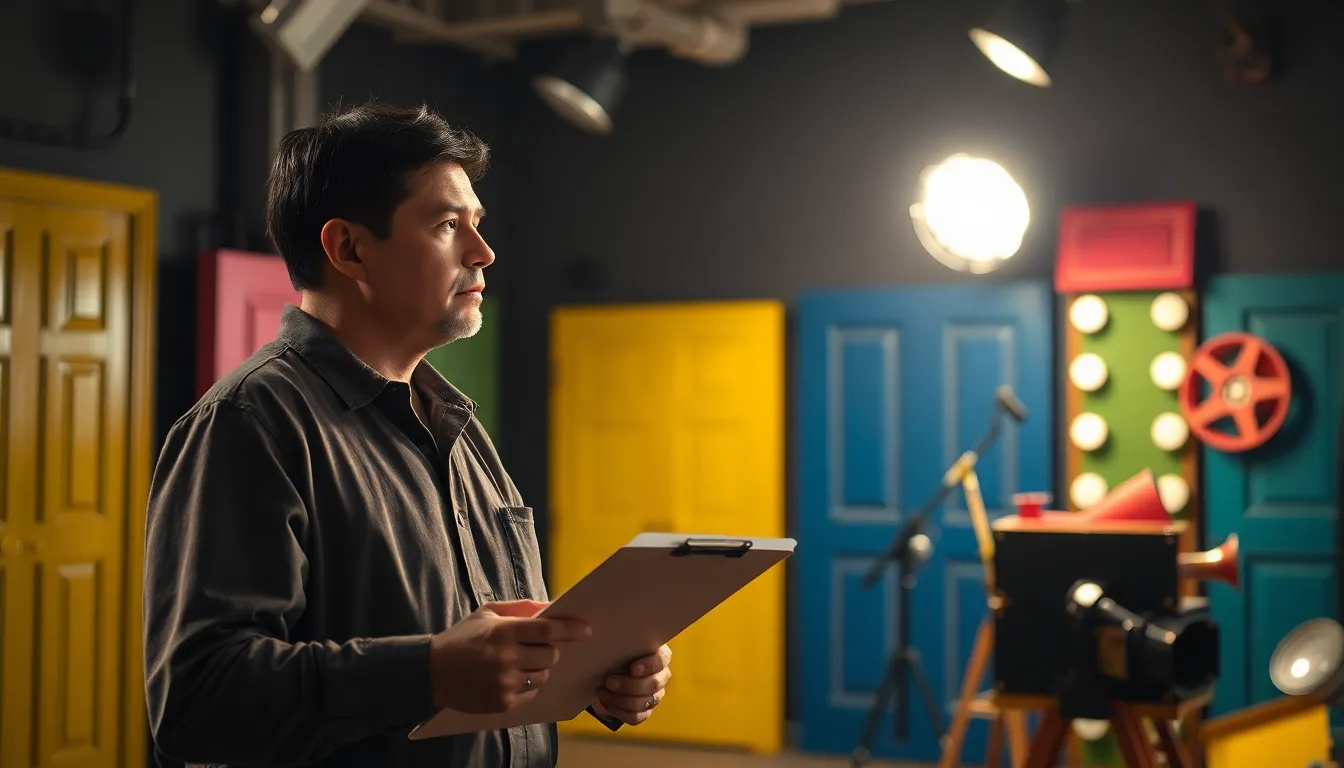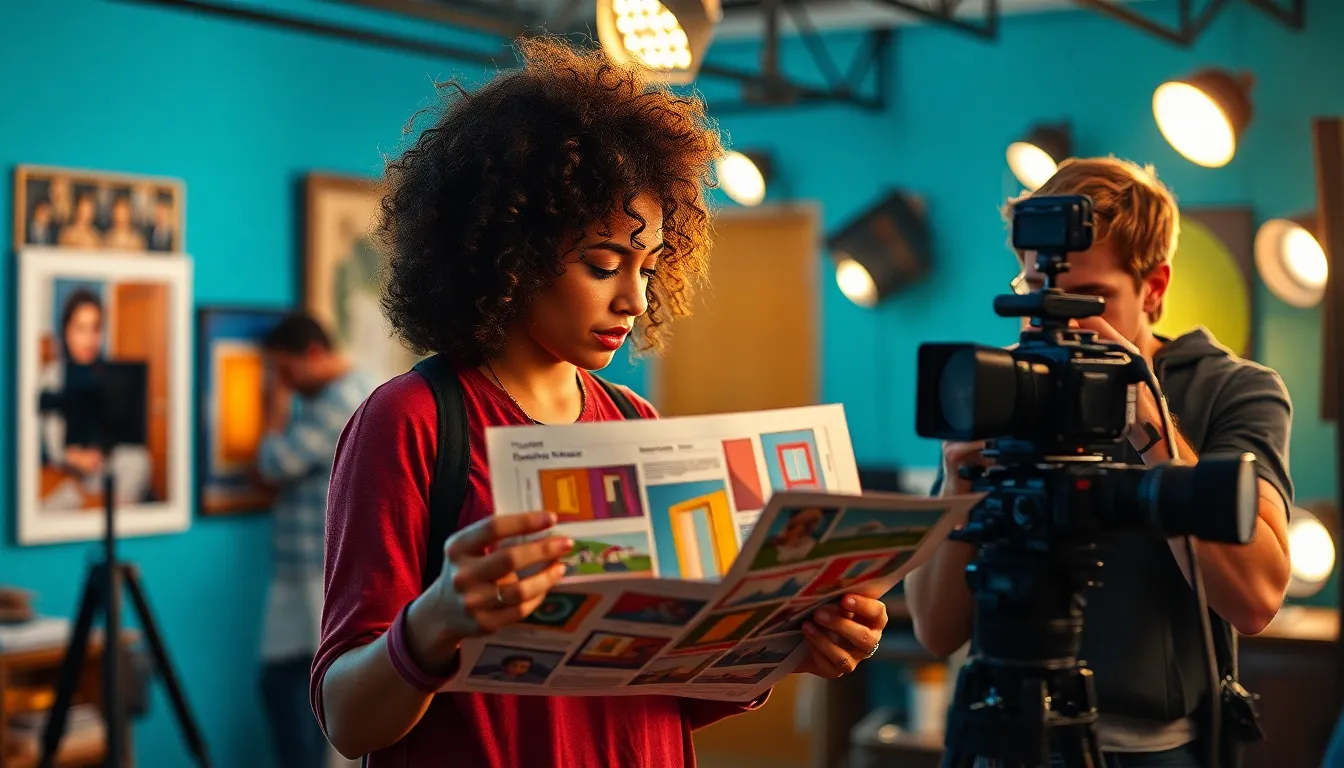Table of Contents
ToggleFilm motifs are the secret spices that elevate a movie from ordinary to unforgettable. They’re like that catchy chorus in a song that sticks in your head long after the credits roll. From recurring symbols to thematic elements, these motifs add depth and richness to storytelling, inviting viewers to dive deeper into the cinematic experience.
Overview of Film Motifs
Film motifs serve as recurring symbols that enhance the thematic composition of a movie. These elements create a sense of coherence throughout the narrative, guiding the audience’s emotional responses. Various motifs appear in different genres, contributing to the overall tone and intention of the film.
Common examples include color palettes, specific objects, and symbolic imagery. Color palettes can evoke emotion, while objects like a recurring key or a significant photograph often hold deeper meanings. Symbolic imagery, such as a rising sun or a falling leaf, can encapsulate themes of hope or decay.
Directors intentionally incorporate motifs to craft distinctive storytelling. They often reintroduce specific visuals or sounds at pivotal moments, reinforcing the film’s themes. For instance, recurring music cues may accentuate dramatic shifts in the plot or highlight character development.
Audiences often resonate with motifs due to their familiarity. Recognizable symbols can enhance engagement, prompting viewers to reflect on their meanings. An example of this is the use of mirrors in various films to symbolize self-reflection and duality.
Analysis of these motifs deepens audience understanding. Scholars studying film often examine how these elements tie into broader cultural or social commentaries. They reveal hidden layers of meaning that audiences might overlook during initial viewings.
Overall, motifs play a crucial role in shaping cinematic experiences. The successful use of motifs can transform a standard narrative into a rich tapestry of interconnected themes, leaving a lasting impression on viewers.
Types of Film Motifs

Film motifs can be categorized into two main types: visual motifs and auditory motifs. Each type plays a significant role in enhancing storytelling and emotional engagement.
Visual Motifs
Visual motifs consist of recurring images, colors, or symbols that enhance the narrative. For instance, the use of a specific color palette can underscore a character’s emotional state. Filmmakers frequently employ symbols like doors to represent transitions or choices. These elements create deeper connections and reinforce themes within the film. Directors often revisit visual motifs at critical plot points, allowing audiences to connect dots and grasp intricate narrative threads. By doing this, they elevate the story beyond mere dialogue and action.
Auditory Motifs
Auditory motifs involve sounds, music, or specific audio cues that recur throughout a film. For example, a particular melody might be associated with a character’s journey or emotions. Filmmakers effectively use audio to evoke feelings, making audiences feel tension or joy through repeated sound patterns. Sound effects may serve as markers for significant shifts, prompting emotional reactions. This approach leads viewers to anticipate events based on auditory cues, enriching the viewing experience. As films utilize auditory motifs, they create a memorable soundscape that resonates long after the credits roll.
Significance of Film Motifs
Film motifs play a vital role in shaping the overall experience of a movie. They reinforce narratives and evoke emotions through consistent symbols and themes.
Enhancing Storytelling
Motifs enhance storytelling by providing visual and auditory hooks that resonate with audiences. Repeating specific colors or sounds creates familiarity and builds anticipation. For instance, a recurring red hue can signify passion or danger, guiding viewers’ interpretations of key scenes. Effective directors utilize motifs to create emotional peaks, making moments more impactful. By weaving these symbols throughout the narrative, filmmakers draw viewers into a deeper understanding of characters and events. As audiences recognize these repeated elements, their engagement increases, fostering a more immersive cinematic experience.
Building Themes
Building themes relies significantly on the strategic use of motifs. Specific images or sounds embody central ideas, reinforcing the film’s core messages. For example, a film that frequently references doors may explore concepts of choice and transition. Auditory motifs, like a haunting melody, can evoke feelings associated with characters’ journeys. Repetition of these elements allows filmmakers to create a cohesive thematic tapestry. Such unity in motifs aids viewers in grasping complex ideas effortlessly. Through high-impact visuals and sounds, films convey deeper meanings, encouraging audiences to reflect on broader societal themes and personal experiences.
Examples of Iconic Film Motifs
Famous visual motifs often shape the viewer’s experience. A striking example is the use of color in “Schindler’s List,” where the girl in the red coat symbolizes loss amidst tragedy. This specific image contrasts against a predominantly black-and-white film, emphasizing the emotional weight of innocence lost.
Symbolic objects also play significant roles in various films. The ring in “The Lord of the Rings” represents power and temptation, recurring throughout the trilogy to highlight its destructive influence. This object-driven narrative underscores the overarching theme of good versus evil.
Another notable auditory motif appears in “Jaws,” where the iconic two-note shark theme signals impending danger. This sound cue prompts heightened tension and prepares audiences for the suspenseful moments ahead. Directors strategically position this motif to create anticipation.
Mirrors serve as powerful visual motifs in numerous films, representing self-reflection and duality. In “Black Swan,” mirrors amplify the character’s internal conflict, illustrating the struggle between reality and illusion. This repeated imagery allows viewers to connect with the protagonist’s psychological descent.
Recurrent motifs like the yellow umbrella in “How I Met Your Mother” signify hope and longing. This item consistently reminds characters and viewers of love’s unpredictability. Such symbolic elements enrich narratives, leading to deeper emotional connections.
The use of birds in “The Birds” communicates themes of chaos and unpredictability. They illustrate the sudden disruption of the idyllic Californian town, heightening the film’s tension. This motific presence reinforces the narrative’s central anxieties, leaving lasting impressions on viewers.
Each of these examples demonstrates how film motifs enhance storytelling. By employing visual and auditory symbols, filmmakers craft cohesive narratives that resonate emotionally with audiences. These motifs elevate themes, making films memorable experiences for viewers.
Film motifs are vital in crafting memorable cinematic experiences. They weave together visual and auditory elements that resonate with audiences on multiple levels. By using recurring symbols and sounds, filmmakers guide emotional responses and enhance storytelling.
These motifs not only reinforce themes but also create a cohesive narrative that invites viewers to engage more deeply. Iconic symbols like the red coat in “Schindler’s List” or the shark theme in “Jaws” illustrate how powerful motifs can shape perceptions and evoke strong emotions.
Ultimately, the strategic use of motifs elevates films from mere entertainment to profound reflections on human experiences, leaving a lasting impact that lingers long after the credits roll.



